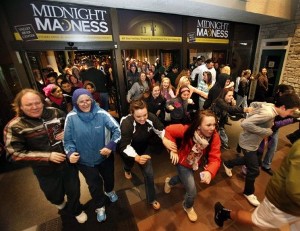 It’s Black Friday and some of you may have black eyes and broken bones upon your return from the stores. I rarely take advantage of Black Friday anymore, because my children are grown and I don’t spend a lot of money during the Christmas season. I also think that people who camp out in front of a store, or fist fight over a flat screen TV that won’t be such a great buy in a few months, are simply nuts.
It’s Black Friday and some of you may have black eyes and broken bones upon your return from the stores. I rarely take advantage of Black Friday anymore, because my children are grown and I don’t spend a lot of money during the Christmas season. I also think that people who camp out in front of a store, or fist fight over a flat screen TV that won’t be such a great buy in a few months, are simply nuts.
Personally, I’ve found that better deals can be discovered after Christmas has passed. Stores are trying to get rid of items that didn’t sell and when it comes to tech gadgets (my weakness), the newer advancements in technology are released after the holiday season ends. Items such as televisions and computers that are discounted during Black Friday are also those that are soon to be discontinued by the manufacturer, or lack many of the features that are available on their counterparts. Discounts on what retail stores have remaining in stock are often found in January and February for better items. Wait 6 months and you’ll find that you really overpaid for that Black Friday “deal.”
However, if you have a shopping list that you just have to fill before Christmas morning, be aware of the pitfalls in allowing your shopping frenzy to overtake your common sense.
Every Black Friday ad promises fabulous prices on toys, clothes, technology and more. But look closer— what seems like a steal in the heat of your early-morning madness may not save you much at all. When you’re shopping, watch out for these Black Friday ad pricing gimmicks:
| The “free” game |
Among the most common ad ploys is the siren song of “free.” The word suggests benefit without risk, but often tricks shoppers into shelling out for items they might not otherwise have bought. Buy-one-get-one-free deals make it seem like the store is giving you a gift, when you’re of course still spending money—perhaps too much money—on item number one. Similarly, online stores that advertise free shipping hope you’ll take a look at wares you might otherwise have ignored. Even when the offer isn’t contingent on a purchase, the retailer benefits: when a shop offers free candy to the first 50 people to arrive, it draws customers in faster and makes them much more likely to buy merchandise.
| Only $99.99 |
Advertisers call listings that end in .99, .90, or .95 “charm prices” because they have such a powerful effect on would-be savers. This happens for a few reasons: first, because we read from left to right, your brain evaluates $12.99 as $12 before your eyes can catch up. Second, precise-to-the-last-digit prices can seem carefully calibrated, making customers less likely to think about the overall value. If the tag says $49.99, fewer people will pause to consider whether that sweater is really worth $50, as our brains think of it as, “forty-something.”
| Rebates |
Particularly common on larger items, rebates can seem like a great deal. Pay $300, but get $50 back—it’s like free money! But here’s how that turns out for most of us… In mid-January, you’ll throw down the rebate form in disgust at how hard it is to fill out, or you will simply decide that you will fill it out later, when you have the time. You’ll find it again around March, expired. Retailers also make the rebate process as complicated and deadline-filled as possible, knowing that the holiday crush will prevent most of us from claiming our money. Some impose as much as 10 weeks of waiting time before you can expect to see your rebate, which means more time for you to forget that it is owed to you and the likelihood that you won’t have retained the contact information to inquire about it. Unless you pride yourself on your bureaucratic zeal, proceed with caution.
| Early openings |
Bear in mind that stores open early not for your benefit, but because they know that the first store you visit is likely to get the largest percentage of your budget for the day. That’s why Walmart, Best Buy, Target and others all open earlier each year for Black Friday. As with free giveaways, retailers are trying their hardest to get you in the door. Be cautious about spending in the first store you hit, and about any advertisement that hinges on urgency. There are plenty of great deals to be had on Black Friday, so don’t let anxiety about missing out persuade you to over-buy.
| Percentage off |
Be aware that manufacturers set their Manufacturer Suggested Retail Price (MSRP) much higher than what they expect a consumer to pay. This allows retailers to give the appearance of a huge discount. A sweater that is “originally” priced at $79.00 and offers a 30% discount may still not be worth the $55.30 after the discount is applied, even though the percentage off being offered sounds like a good deal. Manufacturers are understanding that consumers are expecting huge discounts on Black Friday and throughout the year on sales. They are often supplying goods that they expect will sell for as little as 50%-70% less than what they suggest. It’s all done to give the appearance that the consumer is walking away with a great deal.
Don’t let pricing games ruin your Black Friday fun— or credit score. Instead, come prepared with a shopping list and budget. For larger items, comparison shop ahead of time to find out where the best price truly lies. Armed with a clear set of goals, you can focus on saving.
Disclaimer: On January 4, 2016, the owner of WestEastonPA.com began serving on the West Easton Council following an election. Postings and all content found on this website are the opinions of Matthew A. Dees and may not necessarily represent the opinion of the governing body for The Borough of West Easton.



